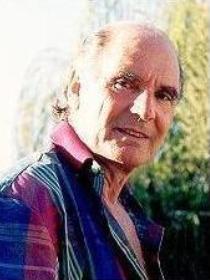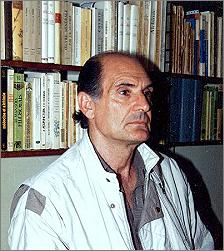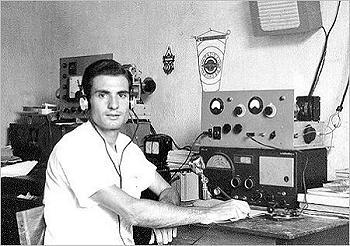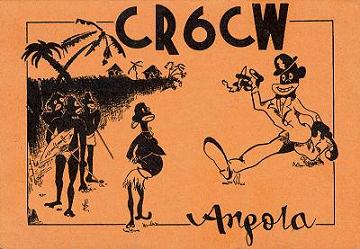Who was Rubellus Petrinus?

Rubellus Petrinus (the Red Stone) is the nom de plume of a Portuguese Alchemist who was born in Bragan?a in the northeast of Trasmontano city, a few kilometres from the Spanish border, on March 25th of the year of the grace of 1931. In 1951, in his 18th year and after having concluded a course in industrial skills, he went to Angola.
With a born tendency for electronics, Rubellus was one of the first ham radio operators in Angola whose handle was CR6CW, which would allow contact with practically everyone in the world. Then, he followed his professional career as an electronic technician in the services of government telecommunications, were given his special aptitude and vast knowledge, he specialized in telecommunications for Hertzian Beam (UHF and SHF) reaching an elevated position in the services hierarchy.
|
|
|
Being a great enthusiast in the practice of underwater photography and hunting, he also formed a small group that was devoted to this activity. Some of the group components were enthusiastic, and passionate about so-called "occult" sciences more properly considered parapsychology and other related subject matters.
One day a friend lent Rubellus a book that would change completely his "hobby". That book was " The Awakening of Magicians" by Jacques Bergier. The reading of that book woke up in him an unheard curiosity, because already for himself he was enthusiastic about the so-called "secret" sciences. Unfortunately, the environment was not favourable for the pursuit of the call to study alchemy. Africa was thousands of kilometres away from the groups that existed in Europe and unlike today, there was no Internet available at the time.
Through a local bookstore he ordered Fulcanelli's book "Le Myst?re des Cath?drales". Its reading left him completely "confused", not only because the text was difficult, but also because it was practically incomprehensible for those unfamiliar with such teachings.
Later on, he ordered another set of Fulcanelli's books in two volumes: "Les Demeures Philosophales". The first book was confusing enough, and these they were not less so, which added difficulty that only created a situation that required some help. However, this experience prepared the "calling" for decolonization and, given the circumstances, Rubellus returned to Portugal, settling in Queluz, a city near Lisbon.

In Lisbon, he entered in contact with other groups dedicated to the "secret" sciences and, in parallel with his activity as a Technician of Telecommunications he manufactured electronic equipment for so-called alternative medicines such as Acupuncture, Biofeedback and Kirlian photography. He continued with enthusiasm in his studies on alchemy acquiring the most well-known alchemists' books, referred to by Master Fulcanelli in his books. However, they were published in Portugal and in Spain as ?Mans?es Filosofais" and "Las Moradas Filosofales" which finally allowed him to better understand Fulcanelli, because the learned language in French was not easy assimilation, above all for one who doesn't dominate the idiom.
Even after reading from the best alchemists' books, he never got to lift completely the allegorical veil, although he already approached the idea of some operations because of the chemical knowledge that he had learned in the texts of Lemery and Glaser.
Later, he also met a small group that was devoted to alchemical study with whom he could exchange impressions and inclusively they made their first experiences. One of the members of the group had knowledge of the Solazaref Filiation in France where he had already travelled in the past. They gathered the interested people and they took a study trip for one week to the said Filiation in France. Only then, having witnessed the real facts, did he understand what was the true alchemy such as the dry way and spagyrics, about which he had read so much. There he understood the reason that the masters gave notice that, without the help of a Master or of a brother's charitable hand it is not possible to learn alchemy. Upon returning to Portugal the group was reduced to three people that worked together under the great Master's Solazaref instructions.
One day Rubellus read the book "Las Palomas de Diana" written by a Spanish alchemist whose nom de plume is Sim?n H. Although he already had vast alchemy knowledge learned through the Filiation, the reading of that book and the way it was written, was not very far beyond his own knowledge, but even so, the group was curious about his relationship with that alchemist. Through its publisher, he got into contact with the referred alchemist keeping a correspondence exchange in which the author always rejected to give any explanation on his said "work", knowing that it was an alchemistic group with knowledge like him or else more advanced still. Therefore, there was no other solution except to travel to Spain to contact him personally. There Rubellus met other Spanish alchemists with whom he still today maintains friendly relationships. During about one year he travelled several times to Fraga a small village close to L?rida, to attend the pupils' meeting with the so-called "Adept". As time went by and as his laboratory and practical experience improved, he reached the conclusion that to follow Sim?n H's teachings and its said "work" was a loss of time and money too. But not everything was lost because he won friends and brothers in the Art.
Later he had knowledge of a very interesting book. "Apocalypse Revelation Alchimique "by Jean of Clairefoitaine. He wrote to the publisher in the sense of contacting the author to make "light" of some doubts about the great Master Kamala-Jnana path described in the book. An answer came to him from an alchemist linked to "Coll?giale Al-kimia" that is "Le Cercle Ext?rieur des Fr?res A?n?s Rose + Croix" in France, informing him that the author had died but that he could help. During this meeting, he got to contact Roger Caro about the Kamala-Jnana path with that he got, at last, the longed-for results. After a year of correspondence exchange with the referred French alchemists, they were invited to visit the group in Portugal, where they could demonstrate the process that they described in writing.
After talking with them he reached the conclusion that those alchemists did not come up to our knowledge, mainly on other alchemic paths and mineral and metallic Spagyria.
In the dry way, working in a group formed by three alchemists including the Solazaref direct disciple, he arrived to do the Eagles in the antimony dry way and he made several attempts inclusively in another wet way exclusively in the Kamala-Jnana's way, but without the results that allowed the conclusion of the work.
In spagyria, he did everything, from the vegetable spagyrics to the metallic and mineral including the great vegetable arcane secret the "salt volatilization" that few alchemists know and the same as some of the ones that know it, the process was taught them by him.
With the theoretical and practical knowledge acquired along about 30 years of study and practice, Rubellus acquired the necessary "background" to understand the "modus operandi" of the ways described in the best classic alchemists' books, as Eirenaeus Philalethes, Flamel, Basil Valentine, Albert the Great, Raymond L?lio and other modern ones like Fulcanelli, Kamala-Jnana and Canseliet that he eventually became capable to write the books "A Grande Obra Alqu?mica" published in Portuguese and Spanish and "Espagiria Alqu?mica" to be published shortly.
Inner Garden is hosting many of Rubellus Petrinus' texts on this page: Pearls of Petrinus.
@nifo@innergarden.org
Inner Garden Foundation
P.O. Box 8520, 3542AD
Utrecht, The Netherlands

